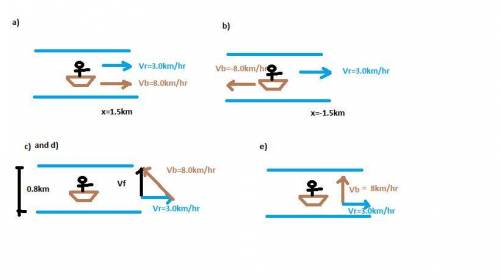
Physics, 01.10.2019 04:30, ayshearouse1203
Aboat can be rowed at 8.0 km/h in still water.
(a) how much time is required to row 1.5 km downstream in a river moving 3.0 km/h relative to the shore?
(b) how much time is required for the return trip?
(c) in what direction must the boat be aimed to row straight across the river?
(d) suppose the river is 0.8 km wide. what is the velocity of the boat with respect to earth and how much time is required to get to the opposite shore?
(e) suppose, instead, the boat is aimed straight across the river. how much time is required to get across and how far downstream is the boat when it reaches the opposite shore?

Answers: 3
Other questions on the subject: Physics

Physics, 22.06.2019 10:40, corrineikerd
When the magnetic domains in a material can be aligned, but eventually drift out of alignment, the material is
Answers: 2

Physics, 22.06.2019 16:30, xxaurorabluexx
An astronaut in space cannot use a scale or balance to weigh objects because there is no gravity. but she does have devices to measure distance and time accurately. she knows her own mass is 77.4 kg , but she is unsure of the mass of a large gas canister in the airless rocket. when this canister is approaching her at 3.50 m/s , she pushes against it, which slows it down to 1.30 m/s (but does not reverse it) and gives her a speed of 2.60 m/s . what is the mass of the canister?
Answers: 1

Physics, 22.06.2019 19:00, yentel110306
Ahorizontal force of 400.0 n is required to pull a 1760 n truck across the floor at a constant speed. find the coefficient of sliding friction.
Answers: 1

Physics, 22.06.2019 23:40, itzdulce
To place a communications satellite into a geosynchronous orbit at an altitude of 22,240 mi above the surface of the earth, the satellite first is released from a space shuttle , which is in a circular orbit at an altitude of 185 mi, and then is propelled by an upper-stage booster to its final altitude. as the satellite passes through a, the booster's motor is fired to insert the satellite into an elliptic transfer orbit. the booster is again fired at b to insert the satellite into a geosynchronous orbit. knowing that the second firing increases the speed of the satellite by 4810ft/s, determine (a.) the speed of the satellite as it approaches b on the elliptic transfer orbit, (b.) the increase in speed resulting from the first firing at a.
Answers: 2
Do you know the correct answer?
Aboat can be rowed at 8.0 km/h in still water.
(a) how much time is required to row 1.5 km do...
(a) how much time is required to row 1.5 km do...
Questions in other subjects:

Mathematics, 19.09.2019 04:30




Mathematics, 19.09.2019 04:30

Mathematics, 19.09.2019 04:30

Mathematics, 19.09.2019 04:30

History, 19.09.2019 04:30

Mathematics, 19.09.2019 04:30

Biology, 19.09.2019 04:30



 is the total velocity of the boat.
is the total velocity of the boat. is the the velcity of the boat relative to the water and
is the the velcity of the boat relative to the water and is the velocity of the river.
is the velocity of the river.

























